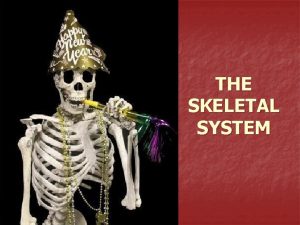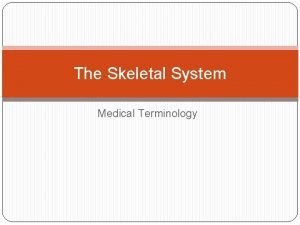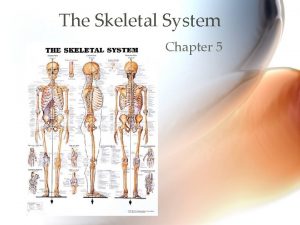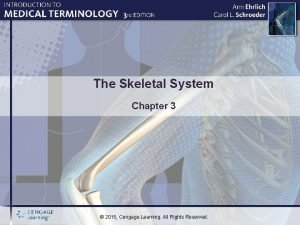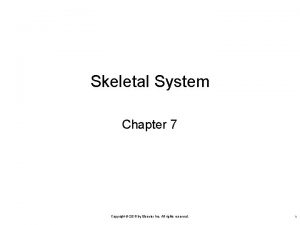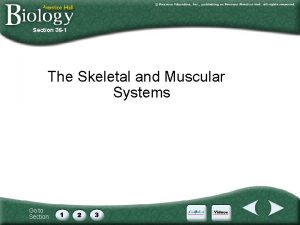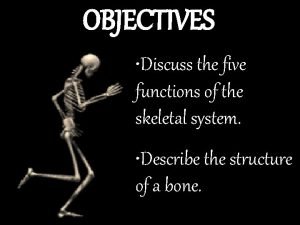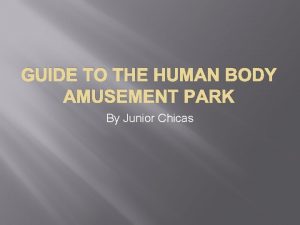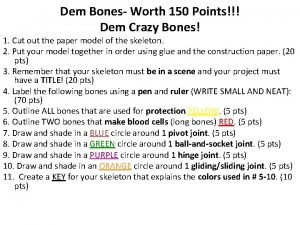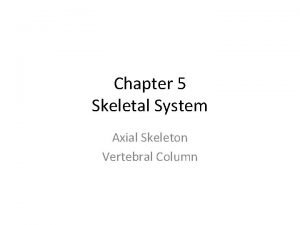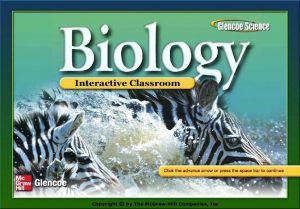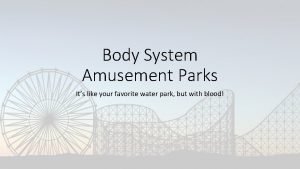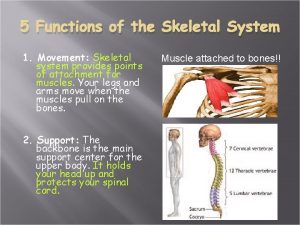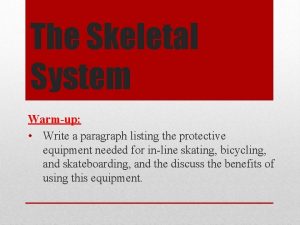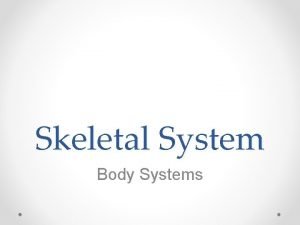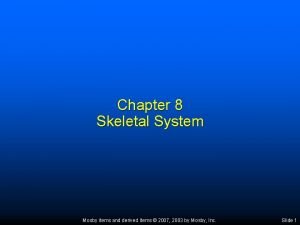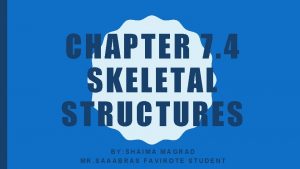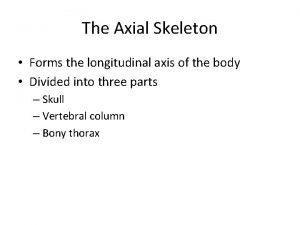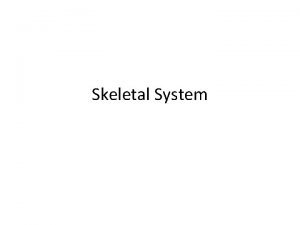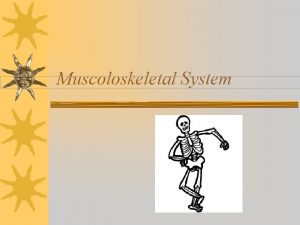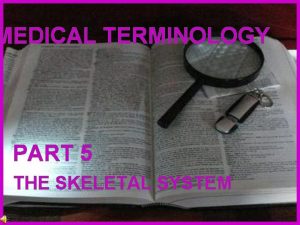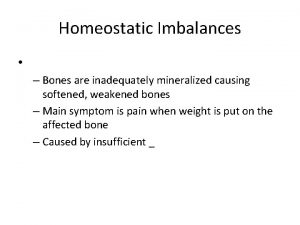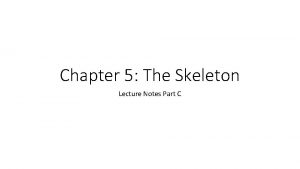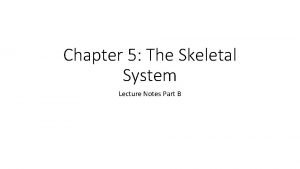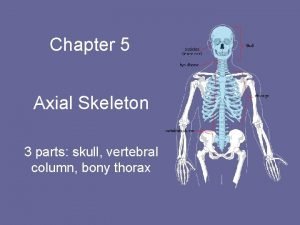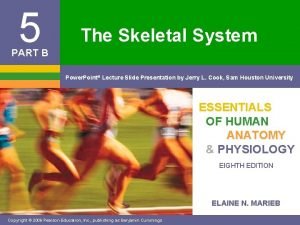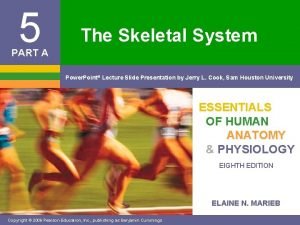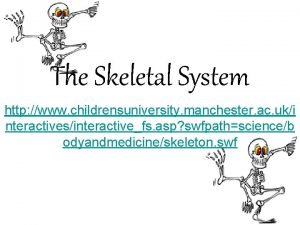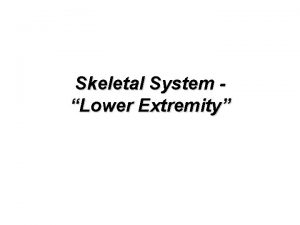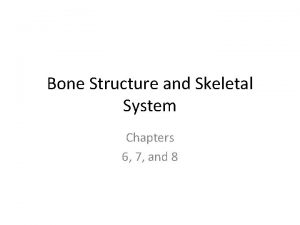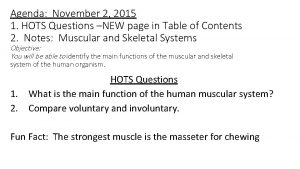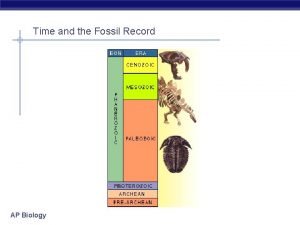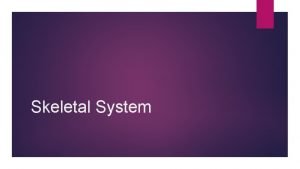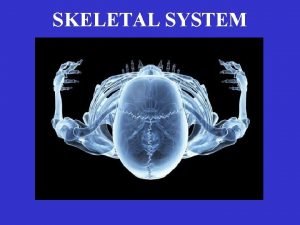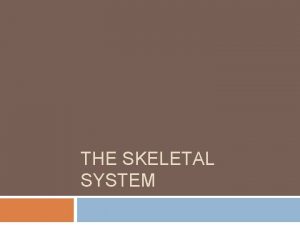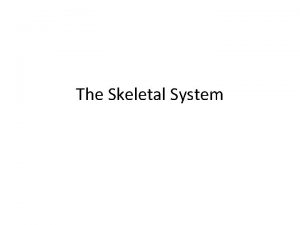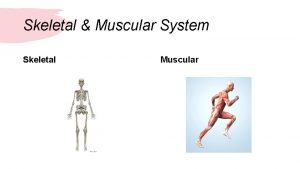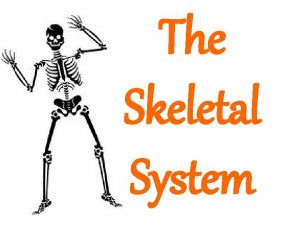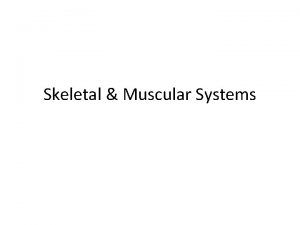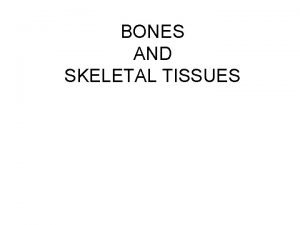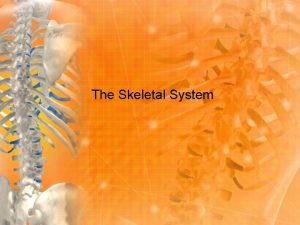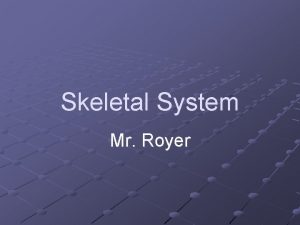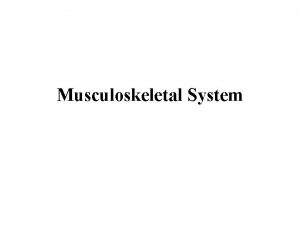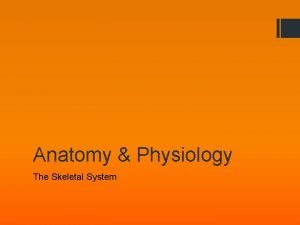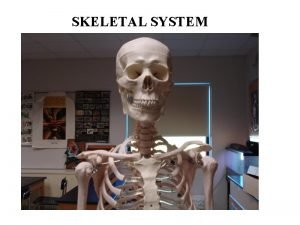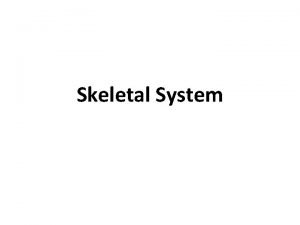The Skeletal System The Skeletal System Components n












































- Slides: 44

The Skeletal System

The Skeletal System: Components n The skeletal system is composed of not just bones, but also ligaments, tendons, and cartilage.

The Skeletal System: Primary Functions n n n Support Protection Movement Mineral storage Blood cell formation

Challenge Question: n How many bones make up the human skeleton?

The Skeletal System: Bone Classification n All of the body’s 206 bones fall into one of two major groups. The axial skeleton forms along the axis of the body and includes the bones of the skull, vertebtal column and ribcage. The appendicular skeleton is made up of shoulder and hip bones, as well the bones of the upper and lower limbs.


The Skeletal System: 4 Types of Bones n Flat Bones- Thin, flat, and usually curved n Long bones- Limb bones, longer than they are wide n Short bones- wrist and ankle bones, cube shaped. n Irregular Bones- do not fit in other 3 categories

Bone Structure n Bone is dynamic, living tissue consisting of a dense, hard outer layer called compact bone and an inner layer of spongy bone.

Bones YOU Need to Know… mandible sacrum scapula

Bone Structure: A Closer Look n Bone is connective tissue, and therefore consists of cells plus a significant amount of extracellular matrix. n Key bone cells include: n Osteoblasts- Bone building cells, secrete calcium compounds and collagen to build the extracellular matrix. n Osteocytes- mature bone cells trapped by the matrix n Osteoclasts- huge cells derived from dozens of fused white blood cells. Digests the matrix as part of the maintaince and repair process.

Long Bone Structure n Shaft is known as the diaphysis. n n Consists of a thick collar of compact bone surrounding a central marrow cavity Expanded ends are epiphyses n Thin layer of compact bone covering an interior of spongy bone.

Bone Structure: Mineral Compounds in the Matrix n Mineral compounds that give bone its stremgth include calcium hydroxide and calcium phosphate. These are concentrated in the outermost part of bone called the periosteom. n Other important minerals include magnesium, sodium and flouride.

Challenge Question… n What has happened to this bone?

Inside bone n Bone marrow- is a general term for the soft tissue occupying the innermost region of long bones, and the spaces within spongy bone. n There are 2 types of bone marrow, RED and YELLOW….

Microscopic Structure of Compact Bone n Made of multiple cylindrical structural units called osteons. n Osteons act like a stack of parallel weight bearing pillars. bone shaft cross-section. canal Osteon Marrow Cavity Extracellular Matrix


An Osteon in Compact Bone Osteocyte remnant Extracellular Matrix canal

Inside Bone: Bone Marrow n Red marrow is thick and deep red. It is responsible for manufacturing new blood cells. n Red marrow is concentrated in flat bones, and the ‘spongy’ ends of long bones. n Yellow marrow no longer produces red blood cells, and is primarily composed of adipose tissue (fat).

Growing Bone: Ossification n There are two types of ossification. Both rely on calcitonin from the thyroid, which regulates metabolism of calcium. n endochonrial ossification occurs when osteoblasts attach to the cartilaginous fetal bones and subsequently lay down calcium phosphate on/within the cartilage. n Intramembranous ossification occurs in a similar fashion, although along a template of membrane, in flat bones



Bone and the Endocrine System: Calcium

Bone Resorbtion: Osteoclasts Resorbtion lesion n Resorption occurs constantly as massive multi-nucleated osteoclasts break down bone releasing minerals back into the bloodstream. n present on the outer layer of bone, just beneath the periosteum , osteoclasts contain numerous mitochondria and lysosomes. They generate an acidic “foamy” cytoplasm containing “collagenase, ” as infoldings in the cell membrane surround and breakdown old/damaged bone. n High levels of calcium, magnesium, phosphate and collagen products are

Did You Know… n When you’re born, all your marrow is red. As we age, it transitions to yellow marrow in most bones.

The Skeletal System: Key Components n Muscles move body parts because they’re attached to bones by strips of dense connective tissue called tendons.

The skeletal System: Joints The junction between two bones is called a joint. Joints are held together by strong bands of connective tissue called ligaments. 3 Joint n Semi-movable Types: Moveable Fixed

Anatomy of a Moveable Joint n Hylaine/Articular Cartilage - a type of tissue that covers the surface of a bone at a joint. . Cartilage helps reduce the friction of movement within a joint. n synovial membrane - a tissue called the synovial membrane lines the joint and seals it into a joint capsule. The synovial membrane secretes synovial fluid (a clear, sticky fluid) around the joint to lubricate it. ligaments - tough, elastic bands of connective tissue attach bone to bone in the joint while providing support and limiting the joint's movement. bursa - fluid-filled sac, cushions and reduces friction in a joint.

Types of Movable Joints

Did You Know… n Because gravity compresses the cartilage in your joints (particularly between your vertebrae) you’re actually about ¾ of an inch taller laying down!

The Skeletal System: Key Components n Ligaments are tough, fiberous connective tissues that connect bone to bone

Challenge question n How are tendons different from ligaments?

The Skeletal System: Key Components n Joint surface at the ends of most bones are layered with hyaline cartilage, which cushions the bone ends and reduces friction during locomotion.

The Skeletal System: Key Components n fibrocartilage ( unique cartilage between vertebrae) owes its flexibility and toughness to both collagen and elastin protein fibers.

Bones: A Closer Look…

Bones: A Closer Look…

Bones: A Closer Look…

Bones: A Closer Look…

Bones: A Closer Look…

Bones: A Closer Look…




Challenge Question… n What does this painting resemble? What structures can you identfy?

That’s All Folks!
 Five functions of the skeletal system
Five functions of the skeletal system Medical terminology skeletal system
Medical terminology skeletal system Chapter 5 the skeletal system
Chapter 5 the skeletal system Chapter 3 the skeletal system learning exercises answer key
Chapter 3 the skeletal system learning exercises answer key Chapter 7:4 skeletal system
Chapter 7:4 skeletal system Chapter 5 the skeletal system figure 5-13
Chapter 5 the skeletal system figure 5-13 Section 36-1 the skeletal system
Section 36-1 the skeletal system What are the five functions of the skeletal system?
What are the five functions of the skeletal system? Your body is an amusement park
Your body is an amusement park Dem bones project
Dem bones project Chapter 6 the skeletal system answer key
Chapter 6 the skeletal system answer key Site:slidetodoc.com
Site:slidetodoc.com Chapter 32 section 2 the skeletal system answer key
Chapter 32 section 2 the skeletal system answer key Skeletal system amusement park
Skeletal system amusement park 5 functions of a skeletal system
5 functions of a skeletal system Navigating the body movements of the body #1
Navigating the body movements of the body #1 How to take care of your skeletal system
How to take care of your skeletal system Arms movement
Arms movement Whats the main function of the skeletal system
Whats the main function of the skeletal system Chapter 8 skeletal system
Chapter 8 skeletal system Chapter 7:4 skeletal system
Chapter 7:4 skeletal system Slidetodoc.com
Slidetodoc.com Skeletal system
Skeletal system Figure 5-13 is a diagram of the articulated skeleton
Figure 5-13 is a diagram of the articulated skeleton Skeletal system bell ringer
Skeletal system bell ringer Axial vs appendicular skeletal system
Axial vs appendicular skeletal system Muscolo skeletal system
Muscolo skeletal system Burs skeletal word description
Burs skeletal word description The pectoral girdle consists of the __________.
The pectoral girdle consists of the __________. Chapter 5 the skeletal system figure 5-13
Chapter 5 the skeletal system figure 5-13 Hyoid bone lecture
Hyoid bone lecture Chapter 5 the skeletal system
Chapter 5 the skeletal system Axial skeleton
Axial skeleton Chapter 3 the skeletal system labeling exercises
Chapter 3 the skeletal system labeling exercises Chapter 5 the skeletal system figure 5-10
Chapter 5 the skeletal system figure 5-10 Chapter 5 the skeletal system figure 5-10
Chapter 5 the skeletal system figure 5-10 Skeletal system
Skeletal system Skeletal system
Skeletal system Where is bone marrow located
Where is bone marrow located Somatic vs autonomic nervous system
Somatic vs autonomic nervous system Chapter 8 skeletal system
Chapter 8 skeletal system Learning objectives of skeletal system
Learning objectives of skeletal system Where is the long bone located
Where is the long bone located Hots questions on skeletal system
Hots questions on skeletal system Fossil record definition biology
Fossil record definition biology
